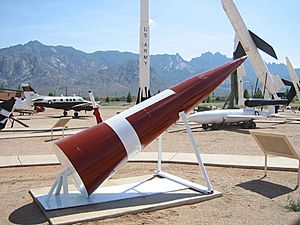White Sands Launch Complex 38 facts for kids
Launch Complex 38 was a special place at the White Sands Missile Range. It was used to test a very important missile called the Nike Zeus. This missile was designed to protect against enemy missiles. The testing site was also known as "Army Launch Area Five." It is located east of the main area of the White Sands Missile Range.
Contents
What Was the Nike Zeus Missile?
The Nike Zeus was a type of anti-ballistic missile (ABM). This means it was built to shoot down other missiles that might be attacking. It was part of a bigger project called Project Nike.
How Did the Nike Zeus Project Start?
In 1957, another missile, the Nike Hercules, was successfully tested at White Sands. This success led to the idea of a more advanced missile, the Nike Zeus. By 1961, plans were made to start building these special missiles.
Testing the Nike Zeus Radar
To find enemy missiles, the Nike Zeus needed a powerful radar system. This system was called the Zeus Acquisition Radar (ZAR). Building for the ZAR started in 1958. It was located near an airstrip. The ZAR had a large power building with nine big generators. It began working in the middle of 1961. Later, another radar, the HAPDAR, was built in the same place.
Where Were the Missiles Launched?
The special buildings for launching the Nike Zeus missiles were designed in 1959. They were finished by 1962.
What Was Inside the Launch Complex?
Launch Complex 18 (LC-18) had several important buildings:
- A Battery Control Building: This building had two radars to track missiles. It also had a computer to figure out how to hit targets.
- A Launch Control Building: This building is now used for the Patriot missile.
- A Launch Cell: This was where the missile was actually launched.
- A tunnel: This connected different parts of the complex.
- Tracking radars: These helped follow the missiles.
There were also special bunkers to store the Zeus missiles safely.
First and Last Launches
The very first Nike Zeus missile was launched from LC-38 on April 28, 1960. It was launched from an underground spot. The last Nike Zeus launch at White Sands happened in December 1963. A total of 72 missiles were fired, but 18 of them did not work as planned.
What Happened After the Nike Zeus Tests?
After the Nike Zeus tests, its radar systems were still used. They helped study how missiles re-entered Earth's atmosphere.
Other Missile Tests at White Sands
White Sands continued to be an important test site:
- In 1964, the first successful Athena test missile was fired into White Sands.
- From 1961 to 1963, a radar called AMRAD was built. It helped assess how different parts of rockets re-entered the atmosphere.
- In 1965, seven HIBEX missiles were tested there.
- The first Sprint missile was launched at White Sands in November 1965.
New Radar Systems and Later Uses
In 1963, work began on a new radar system called the Multi-function Array Radar (MAR-I). This radar was based on the Zeus Acquisition Radar. It later helped create the Missile Site Radar in Kwajalein.
The last part of the Nike Zeus facility stopped working in February 1974. Much later, during the War on Terrorism, the old tunnel complex was used for training. It helped soldiers practice in areas that looked like a Taliban combat zone.
Images for kids



